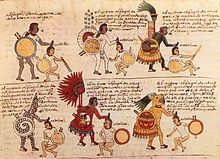Aztec military
This article deals with the military of the Aztecs .
Army and Society
The Aztec society was in box divided. Similar to the priestly caste , the warrior caste enjoyed a high reputation. There was no standing army . But all Aztecs of military age were required to do military service . So in case of war there were always enough men available. But there were also professional warriors who aspired to rise higher in society. They received military training and passed certain tests. Every Aztec, whether trader, craftsman or farmer, was able to rise in society in this way. However, if a warrior was guilty of misconduct, he was punished more severely than a peasant. For the warrior there was mostly the punishment of personal sacrifice for the gods, while a peasant only lost his freedom and was made a slave .
Classification and rank

The army was well organized. The largest units united in calpultin (singular calpulli ). It was a regional unit, similar to a company . Twenty calpultins were stationed in Tenochtitlán . They were grouped into four larger units and were led by the relatives of the Tlatoani (emperor). Other smaller units of the Aztec Army had strengths of 800, 400, or 200 warriors respectively. They were led by noble officers . There were also special elite military units , such as the eagle and jaguar warriors . They could easily be recognized in battle by their cotton clothing , the Huitzilopochtli symbols on their shields, the eagle's feathers or the fur of the jaguar . The Otomi (Otontin) were another warrior caste famous for their strong fighting ability. There was also the "shorn" ( Cuachicqueh ). They were the most renowned warrior society and had shaved their heads except for a long braid over their left ear. They painted their skulls and faces blue and red or yellow. They had publicly vowed not to take a step back during the fight. Although the Mexica did not use uniforms, the military units could be identified by their feathers of the same color. The officers could be recognized in the battle by their particularly conspicuous plaster and their extraordinarily long wooden standard ( Pamitl ) with the plume and the flag. Based on their design and color, the warriors could keep an eye on their leaders. They attached this standard to their back so that it would not be a hindrance. This made it easier for them to take prisoners in battle.
There were six ranks for the civil warriors, symbolizing military and social advancement. These ranks could be recognized by the increasingly elaborate clothing of the warriors. While a warrior who had only taken one prisoner had to fight in light clothing and without lavish insignia, a warrior who had already captured six opponents was allowed to wear a yellow tlahuiztli . This garment was made from the fur of a puma . Such warrior was also carved helmet from hardwood awarded.
Clothing and protection
The Aztec warriors wore heavily padded collars . The fabric was hardened with a brine and was called Ichcahuipilli . It consisted of cotton and agave fibers and could cover the whole body or just the upper body and stomach. This “armor” was as thick as two fingers and sufficient to protect the warriors from arrows and other projectiles. There was also the round shield ( chimalli ) made of wood or braided fibers. Some shields were made of very thick cotton and could be rolled up for the march. There were also magnificently decorated shields ( māhuizzoh chimalli ) decorated with many feathers. The warriors dressed up for the war. They adorned themselves with artistic war paint and lots of beautiful feathers. Some wore carved hardwood helmets on their heads, symbolizing various animals.
Armament
The Aztecs did not master blacksmithing. That is why their weapons were made of wood, stone and obsidian . As weapons of attack they use spears , which they threw with the help of a spear thrower , the atlatl . However, they also carried a heavy lance , the tepoztopilli . Its point was equipped with obsidian blades. In addition to the short obsidian sword ( maquahuitl ), long swords of this type were also used. They were held with both hands, but were not as long as the European halberds . They only used clubs and hatchets in close combat . An important long-range weapon was the slingshot ( Tematlatl ) made of leather or plant fibers. This enabled the warriors to shoot stones up to the size of a fist over long distances with great accuracy and force. In addition, were arrow ( Mitl ) and bow ( Tlahuitolli ) was used. This long-range weapon had the greatest range, was very accurate, but did not have the penetration power of a lance or a spear.
literature
- Ross Hassig: Aztec Warfare. Imperial Expansion and Political Control . University of Oklahoma Press, Norman 1988, ISBN 0-8061-2121-1 .
- Gustav Friedrich Klemm : Allgemeine Cultur-Geschichte der Menschheit , Volume 5, Teubner-Verlag, 1847, chapter: "The war system", p. 78 ff.
Individual evidence
- ↑ Hanns J. Prem : The Aztecs. History-culture-religion. Beck, Munich 2003, ISBN 3-406-45835-1 , p. 19.
- ^ Hanns J. Prem: Die Azteken-Geschichte-Kultur-Religion , Verlag CH Beck, ISBN 3-406-45835-1 , p. 53.
- ^ Bernal Díaz del Castillo: History of the Conquest of Mexico, 1988, p. 254
